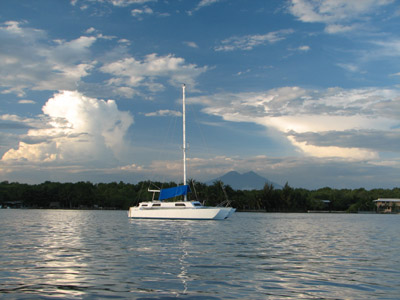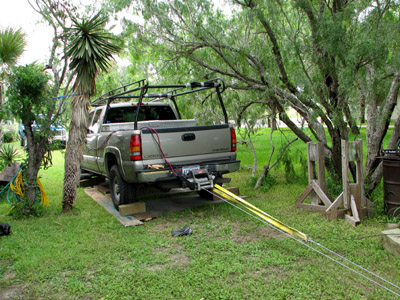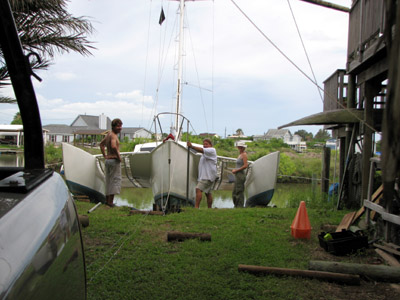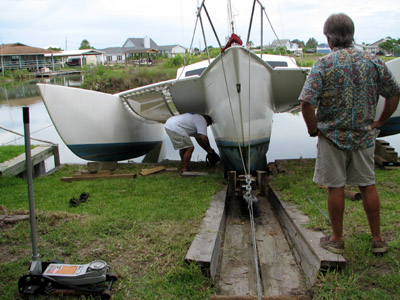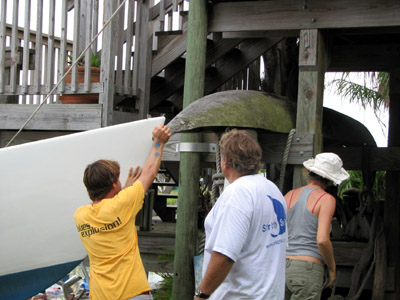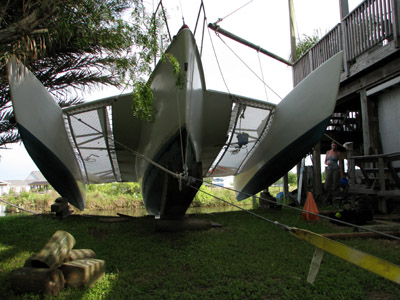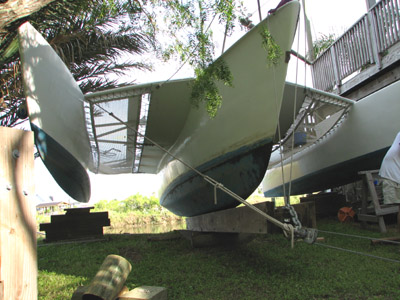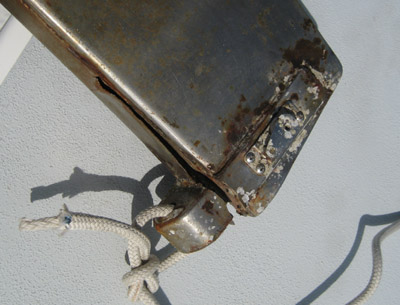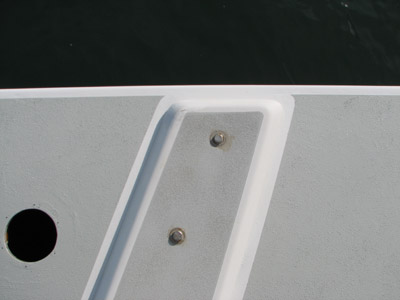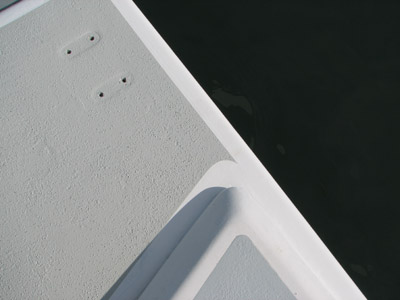We are done painting. Well, not actually DONE done, but done enough. During this time, the whole boat has been in an uproar: a minefield of scattered painting equipment, gaping holes where the trampolines are untied, various logs scattered about waiting to be triped over, and freshly painted ‘wet’ spots, which we can’t touch until we feel the paint has completely set. The dinghy has been migrating all over the boat as we have been covering the hulls with fresh paint. Last week I chucked the coffee grounds right into it, since it was not in its customary location. Freakin’ mess, that was. If we could have hauled the boat out or something, all the work could have been completed at once and the pain in the ass, although acute, would have been short lived. As it was, we had to beach the boat upon the sandbar every day where we had maybe three hours of work time without water underfoot. Basically we would push the Time Machine over with the dinghy (the outboard is currently on the dinghy), snag the mooring ball over the shallow bar, kick up the rudder, and wait. Once the center hull touched bottom, we would spring into action and begin tying our support sticks (7-foot long sturdy drift-logs we scavenged off the beach) to the A-frames. This would keep the boat upright as the water receded, leaving the amas floating in air. As soon as the boat settled and the amas were out of the water, we hop into the knee-deep water and run around the boat scraping crap off the bottom and getting ready to do what we had to do for the day. Once the water was almost gone, we sand or paint as fast as we could until the water started to come back in. We’d generally be still sloshing around until it was knee-deep again before climbing back onto the boat to wait for the amas to float. Then we’d untie the support sticks and wait some more while the boat bumped around until it was finally free. Then we’d push it back over to deeper water to anchor as usual. We had to do this seven times to get the bloody thing painted.
The two-part epoxy paint still sucks balls but we are stubborn enough that we decided to deal with it until the entire hull was painted. In addition to the hellish paint situation, we have been having all sorts of issues with our generator. We got gas at the hotel a while back and something was up with it because as soon as we filled the tanks of our outboard and generator, they stopped running. This caused considerable consternation on our parts. We didn’t know what the problem was for some time but suspected the gas after we had the oil changed by a local dude and he took an alarming amount of water and grit out of the fuel tank. We mentioned this in passing once to Murray, who has a small haul-out facility here and works closely with the hotel to make it ‘cruiser-friendly’ and he was very defensive. “I buy more gas here than ANYBODY on the ENTIRE estuary and have been for four years and I have never, NEVER, gotten any bad gas.†He went on in this vein for some time and we were sorry we had mentioned it but we still weren’t convinced it wasn’t the gas. We got some other gas from the Texaco up the way and it was fine. So to make a long and wholly infuriating story short, both generator and outboard are running more or less okay in the end. We made one trip to San Salvador for spark plugs and another to Zacatecaluca for more; Joshua took the generator apart no less than five times and the outboard, three. Much swearing occurred. Both seem to be going through the spark plugs with the suspect gas but seem to run okay and normally with the other gas. Joshua thought maybe it had diesel mixed in with it. We noticed yesterday that there is a “sale†on regular at the hotel gas station: $2.85/gallon. We’re not falling for that shit.
In the meantime, we applied the nonskid finally to the topsides of the amas. The paint was Petit ‘Pearl Gray,’ which we had leftover from the States. It is a one-part standard boat paint and it went on beautifully. Amazingly. I was in raptures applying it, seriously. I put on one coat plain and then mixed the nonskid (a kind of pointy plastic sand) in to the paint for the second coat. Usually, with an aggressive nonskid like the one we were applying, it is generally sprinkled onto wet paint, then the remaining unstuck sand is vacuumed up, then a final coat is applied over the top to hold it down. Because, as I may have mentioned once or twice, it is typically no less than two billion degrees during the day, paint dries practically the moment it is applied. Which is why I mixed the sand with the paint to apply with a roller. It required irritating fanaticism to lay down evenly but it worked out in the end. Once applied, it looked awesome and in our zeal to behold the miracle, we happily ripped off the masking tape and headed triumphantly to the hotel to drink a cold beverage and brag to the Internet about how awesome we were.
We gave it a day or two to really set before we dared to dip a toe upon the decks. I decided to test a spot under where the cleat would go to see if I could rub off the nonskid (to see if it was stuck down well enough—a test that may have been more prudent to do, say, the same day we painted) and, it just came right off. Oh Crap. There was no way in hell that I was going to do any more sanding on the nonskid and so fuckit, I just dusted it off and painted another coat right over the top. Joshua re-taped for me. Now, it looks exactly right and the non-skid is completely stuck down. So…cough… I just hope that it doesn’t peel up or whatever horrible thing is supposed to happen if you don’t sand before painting.
We got the generator running just in time to go back up on the bar again. This time we were going to sand the main hull and paint it; it would take us two days on the bar. Day 1 went basically fine, except I didn’t lash my support sticks as well as Joshua did and mine settled too far into the sand, setting the boat at an alarming tilt. The ama wasn’t exactly touching the sand on one side, but close. Oops. Sanding sucked as it always does and we floated off the bar six hours later a dusty, muddy mess.
Day 2: Joshua had the brilliant plan to lay the boat on the bar ass-end to the outgoing current (normally we are nose into the current). The reasoning here is so that the outer ama we wanted to touch up (remember the gashes the port-a-bote made?) would be in the shade and maybe some other reasons. This was very awkward because with the current, we fishtailed around and finally settled at a rakish 45-degree angle to the current. The stern then proceeded to kick up all sorts of funky eddy things and dig itself way down into the sand so that the boat finally settled pointing up. Looked flat-out ridiculous but whatever. We could still reach the tip of the nose to paint so we didn’t fuss too much over it. Then this gnarly wind kicked up. This made painting nearly unbearable and once again, I burst into tears at the evilness of this paint. With the wind though, paint was flying everywhere. Pouring it from the canister into the tray was a major feat and we had to hunker down under the wing of the ama to find a less-windy spot so that the paint stream wouldn’t atomize and spray all over us. Not that we escaped being covered head to toe with bits of paint cobweb and splatters. I even got it in my eye at one point, causing Joshua to freak out and dump a bunch of funky estuary water up my nose in an attempt to “flush†out my eye. Gack. It’s still all over my face in hopes that it will be easier to rub off after a few days.
We got about two and a half coats on the mainhull and decided to call it done. We were out of paint and didn’t have time to mix more before the tide came back in anyway. From a distance it looks pretty good.
